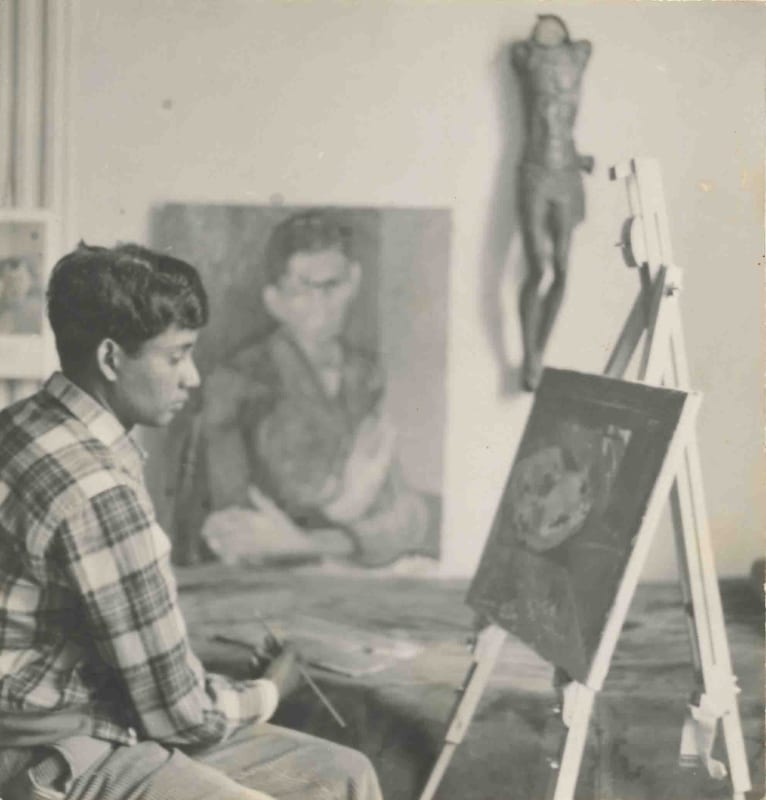Albert Adams South African, 1929-2006
Albert Adams (1929-2006) is perhaps one of South Africa’s greatest Black Modernists. In 1959 he held a seminal exhibition in Cape Town, which drew the critical attention of the white community. Both the art historian Neville Dubow and the director of the National Gallery Mathys Brokhaust wrote positive reviews in the press. Dubow referred to Adam’s work as having a ‘brilliant expressionist technique’. Despite Adams’ works overt critique of apartheid, several paintings from this exhibition were collected by both the South African National Gallery and the Johannesburg Art Gallery, including his South Africa (1959) — known as the ‘South African Guernica’.
Adams went to university in London at Slade School of Fine Art and furthered his studies in both Germany and Austria. His teacher, the Austrian Expressionist Oskar Kokoschka, said of his young pupil ‘he set is teeth into a kind of root that is new to most of our contemporary artists.’ The renowned South African art historian, Marilyn Martin, stated that Adams ‘was a great artist… [with an] unwavering commitment to his art.’ For many decades Adams was ignored, partly because of his race but also because he left South Africa in 1960 and led a somewhat reclusive life in London. Adams is now finally receiving critical attention both in the UK and America.
His expressionist technique was influenced by Oskar Kokoschka, Francis Bacon, and Pablo Picasso. Some of Adams’ most accomplished works are his self-portraits, that interrogated his racially and sexually fluid identity. One of his overarching themes included the violence and injustice of apartheid South Africa. As one of his admirers put it ‘Adams fought a war against injustice; against ignorance; against anything that diminished the human spirit.’
Albert Adams was born in Johannesburg in 1929 to a Coloured (or mixed race) domestic worker and an Indian father, who worked as an indenture labourer. His mother left Johannesburg with him when he was four years old. In Cape Town, he lived at his grandmother’s overcrowded tenement house in District Six. Despite the poverty he grew up in, Adams was a diligent child who excelled at school. He was enrolled at Livingstone High where he was made headboy.
Adams, much like his school friend and fellow artist Peter Clarke, was drawn to art. With Clarke, he attended John Coplans’ non-racial after-hours art group in 1947. After finishing school at Livingston, Adams was rejected by the University of Cape Town’s Michaelis School of Fine Arts on account of his race.
With few prospects, he began work as a window-dresser in Cape Town. This enabled him, financially, to enrol at what was the coloured Hewat Teacher Training College. There, he became politically active, becoming the local head of the National Union of South African Students (NUSAS).
Adams was arrested on several occasions which had a decided effect on his work. As he would once admit many years later: ‘My work is based on my experience of South Africa as a vast and terrifying prison.’
By the age of about nineteen, Adams had begun to frequent artistic circles in Cape Town. And like the other great South African modernist, Ernest Mancoba, his talents were recognised by Irma Stern and her circle. Stern and her two friends, Rudolf von Frieling and Siegbert Eick, advised Adams to apply to the Slade School of Art — a school in London that had, from its inception in 1871, accepted students regardless of race, gender, or religion.
In 1953 Adams was accepted to Slade and awarded a scholarship, There he studied with an impressive array of talented African artists including Ibrahim El-Salahi. At Slade, he was taught painting by Lucian Freud and printmaking Anthony Gross. In his second year he was awarded the Summer Composition Prize. Sir Willian Coldstream the principal of Slade too took a particular interest in Adams.
In 1956, he was awarded a Bavarian State scholarship to the Munich Academy of Art, where he studied printmaking under the renowned printmaker Adolf Thiermann. During the summer of 1957, he attended master classes with famous Austrian expressionist Oskar Kokoschka at his ‘School of Vision’ in Salzburg. Kokoschka had a major influence on Adams as a painter.
Adams returned to South Africa in 1958. There he worked on two of his, perhaps, most famous works, South Africa 1958-59 (Deposition) and South Africa 1959. The first depicts a black Christ figure with two disciples, and the second, with its prophetic vision of violence, has been more commonly referred to as ‘the South African Guernica’. The paintings were produced at the time of the infamous Treason Trial, the mass arrests, and an ever-increasing state violence.
In 1960, Adams left South Africa, returning to London. Letters reveal his desperation to get out of a country whose violence and racial and homophobic laws were reaching a crescendo.
As Adams related to Judge Albie Sachs, London was a place where he could ‘develop his art and express his love for his companion.’ He lived in London with his partner, Ted Glennon until his death.
In the 1960s, he befriended the curator and African art historian Dennis Duerden, who wrote the influential monograph African Art (1968). Adams worked with Duerden at the BBC and participated in many discussions and interviews concerning African art and literature. He also produced several book cover designs for the famous Heinemann African Writers Series. In 1979, Adams became a lecturer at the City University in London in art history, a position he held until his retirement. He continued to make work until his death in 2006.




